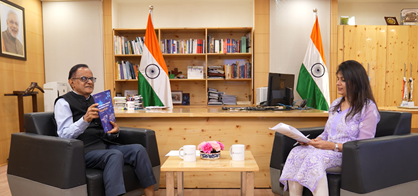A Quantum Shift in India’s Global Technology Diplomacy
India has made a powerful statement on the global tech stage. On World Quantum Day 2025, the Office of the Principal Scientific Adviser (PSA) to the Government of India released the first-ever International Technology Engagement Strategy (ITES) for Quantum.
This new strategy outlines how India will engage globally in the fast-moving world of Quantum Science, Technology, and Innovation (QSTI). It aims to create strong international partnerships and unlock quantum’s full potential across sectors.
2025 also marks the International Year of Quantum Science and Technology, giving this launch special global relevance.
Why the ITES for Quantum Matters
Quantum technology holds the key to breakthroughs in computing, secure communication, and advanced simulations. International Technology Engagement Strategy can improve sectors like healthcare, finance, space, and even how platforms like Netflix recommend content.
Because of its growing importance, no country wants to fall behind. That’s exactly why India has chosen this moment to declare its ambitions clearly.
From Hardware to Global Standards: India’s Quantum Vision
Prof. Ajay Kumar Sood, PSA to the Government of India, presented the report during the Office of PSA’s podcast. He stressed one key idea: no nation can afford to be left behind in quantum.
He highlighted India’s need to reduce dependency on imports for quantum hardware. Investment is key. So is de-risking innovation. That means creating a space where startups, industries, academia, and government collaborate actively—and fearlessly.
Another critical gap Prof. Sood mentioned was the absence of global quantum standards. India wants to help define those standards. Why? Because defining global standards is not just about leadership—it’s about market access and influence. If India helps shape the rules, it also shapes the future.
A Hub-and-Spoke Model Backed by the National Quantum Mission
At the heart of India’s quantum ecosystem lies the National Quantum Mission. It’s run by the Department of Science and Technology (DST). This mission is working across the full life cycle of quantum development—from research to real-world products.
India’s NQM is built on a hub-and-spoke model. It brings together 152 researchers from 43 institutions across 17 states and 2 union territories. This distributed model helps scale innovation across geographies, not just cities.
The mission focuses on translating cutting-edge R&D into market-ready products. That’s how innovation goes from paper to practice.
A Strategy for Partnerships and People
The ITES for Quantum is not only a technology map. It’s also a diplomatic tool. It’s built to help India’s missions abroad work more effectively in forging quantum partnerships.
From investment analysis to talent development and intellectual property, the strategy offers deep insights. It gives a snapshot of India’s strengths—and the gaps that need attention.
It is also meant to guide foreign governments and companies. It helps them understand where and how to collaborate with India. This is a move toward co-creation of technologies, not just technology transfers.
What It Means for the Common Citizen
At first glance, quantum tech may feel distant. But its applications will touch everyday lives. It can lead to better healthcare, secure communication, faster internet, and even advanced Netflix-like content recommendation systems.
Yes, even entertainment platforms could get a boost. With quantum computing, data processing could become exponentially faster. AI models that power platforms like Netflix could become sharper, more efficient, and truly real-time.
A Thoughtful Step Toward a Technologically Sovereign India
With ITES-Q, India signals it is ready to play a bigger role in global quantum conversations. The strategy is not just a declaration—it is a commitment to being a proactive player in shaping the quantum future.
And as Prof. Sood said, this is just the beginning. To truly lead, India must now turn this roadmap into results. With the right investments, global partnerships, and homegrown innovation, India’s quantum leap might just inspire the world.







Leave a Reply